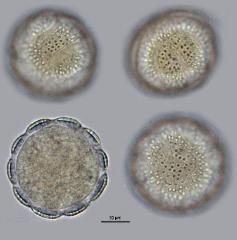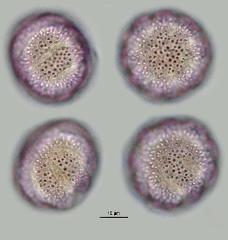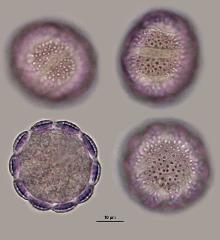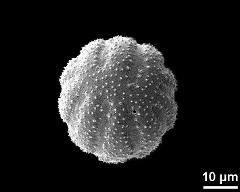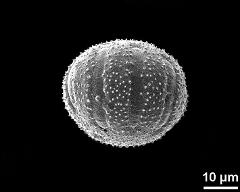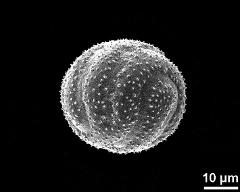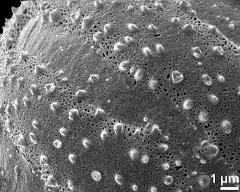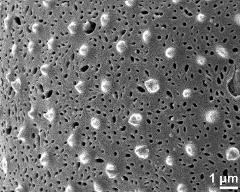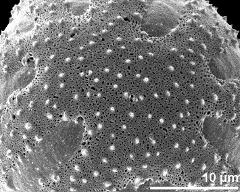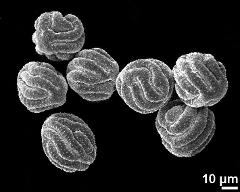Anemone hortensis
Taxonomy: Angiospermae, Ranunculales, Ranunculaceae, Anemone
Links: http://flora.nhm-wien.ac.at/Seiten-Arten/Anemone-hortensis.htm
Published: 2020-11-10
Pollen Description
Shape, Size and Aperture
pollen unit: monad, dispersal unit and peculiarities: monad, size (pollen unit): medium-sized (26-50 µm), size of hydrated pollen (LM): 31-35 µm, shortest polar axis in equatorial view (LM): 26-30 µm, longest polar axis in equatorial view (LM): 31-35 µm, shortest diameter in equatorial or polar view (LM): 31-35 µm, longest diameter in equatorial or polar view (LM): 31-35 µm, pollen class: colpate, polarity: -, P/E-ratio: -, shape: spheroidal, outline in polar view: circular, dominant orientation (LM): oblique, P/E-ratio (dry pollen): -, shape (dry pollen): spheroidal, outline in polar view (dry pollen): lobate, infoldings (dry pollen): aperture(s) sunken, aperture number: >6, aperture type: colpus, aperture condition: colpate, aperture peculiarities: aperture membrane ornamented, stephanoaperturate
Ornamentation and Structure
LM ornamentation LM: scabrate, verrucate, gemmate, nexine: -, sexine: -, SEM ornamentation SEM: perforate, microechinate, suprasculpture SEM: -, TEM tectum: -, infratectum: -, foot layer: -, endexine: -, intine: -, wall peculiarities: -, supratectal element: -
Miscellaneous
pollen coatings: -, reserves in cytoplasm: -, cell number: -, Ubisch bodies: present
Annotations: apertures often irregularly arranged; spiraperturate grains as well
Author(s) of diagnosis: Halbritter, Heidemarie; Heigl, Helmut
Pictures
Picture legend
- hydrated Pollen - fresh, glycerine, unstained, photographer: Heigl, H.
- hydrated Pollen - fresh, glycerine, ruthenium red, photographer: Heigl, H.
- hydrated Pollen - fresh, glycerine, ruthenium red, photographer: Heigl, H.
- polar view - fresh, rehydrated (water) & critical point dried & sputter coated with gold, photographer: Halbritter, H.
- equatorial view - fresh, rehydrated (water) & critical point dried & sputter coated with gold, photographer: Halbritter, H.
- equatorial view of a spiraperturate pollen grain - fresh, rehydrated (water) & critical point dried & sputter coated with gold, photographer: Halbritter, H.
- aperture - fresh, rehydrated (water) & critical point dried & sputter coated with gold, photographer: Halbritter, H.
- exine surface - fresh, rehydrated (water) & critical point dried & sputter coated with gold, photographer: Halbritter, H.
- polar area - fresh, rehydrated (water) & critical point dried & sputter coated with gold, photographer: Halbritter, H.
- dry pollen grains - dry, sputter coated with gold, photographer: Halbritter, H.
Literature
- (1998) Preparing living pollen material for scanning electron microscopy using 2,2-dimethoxypropane (DMP) and criticalpoint drying. Biotechnic Histochem 73: 137–143
Copyright and Citation
Cite this publication as:
Halbritter H., Heigl H. 2020. Anemone hortensis. In: PalDat - A palynological database. https://pc8.botanik.univie.ac.at/pub/Anemone_hortensis/303868;jsessionid=3C142AA996E7886EC2E001872AAC2166; accessed 2025-01-10

